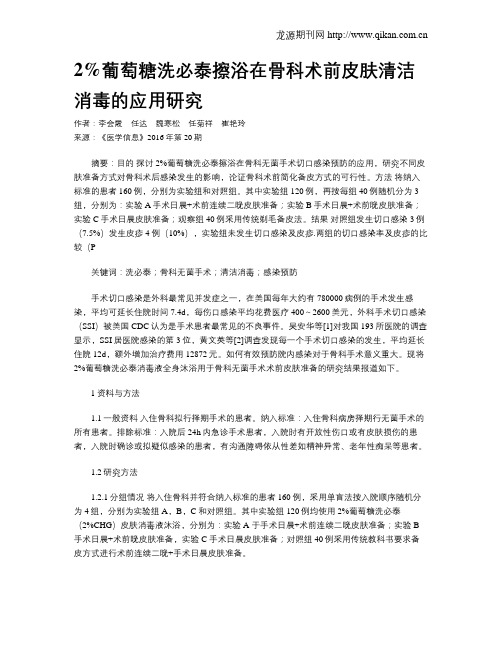每日使用葡萄糖酸洗必泰抗菌沐浴的意义
消毒产品使用说明

皮肤医用抗菌敷料(喜美健)使用说明书包装规格:30ml适用范围:适用于人体体表、小面积皮肤和粘膜创面感染的预防及辅助治疗。
用法用量:1、用于头部、脐部、肢体皮肤、手足部位皮肤杀菌、皮肤新鲜破裂等使用时:用本品直喷患部,日喷3~5次,症愈即可停用。
2、用于各种原因引起的皮肤感染时:用本品直喷患部,日喷3~5次。
3、用于阴道、肛门皮肤感染时:用本品直喷患部,日喷3~5次,症愈即可停用;或取本产品适量按1:4的比例用凉开水稀释后冲洗。
4、用于口腔感染或口腔溃疡时:用本品对准口腔患处均匀喷洒,含漱作用5分钟后吐出,用清水漱口即可。
5、用于创伤、烧伤、烫伤、褥疮、溃疡、伤口及粘膜的感染时:用本品直喷患部,日喷3~5次,症愈即可停用。
6、用于儿童皮肤感染时:用本品直喷患部,日喷2~3次,症愈即可停用。
7、炎症消失后建议继续使用本品一周左右,以巩固疗效。
注意事项:1、内装外用杀菌制剂,不得口服。
置于儿童不宜触及处。
2、请在医生指导下使用,若对粘膜使用过量时,可能出现后、粘膜红肿现象,应停用并咨询医生。
3、避免与有机物和拮抗药同时使用(如肥皂等阴离子洗涤剂、碘或过氧化物),以免影响疗效。
4、对本品双烷基季铵盐、甘油、薄荷等成分过敏者忌用。
贮存:在相对湿度不超过80%且无腐蚀性物质、通风良好的室内,密封,置阴凉干燥处保存。
伊洁士牌75%消毒酒精产品说明:主要成分为乙醇,含量为73%-77%,可杀灭肠道致病菌、化脓性球菌、致病性酵母菌和医院感染常见细菌。
使用范围:适用于手术和注射部位的皮肤消毒。
使用方法:用无菌棉签或棉球直接蘸取本品原液涂擦皮肤作用2分钟。
注意事项:为外用消毒液,不得口服;不能用于外科器械消毒;乙醇过敏者慎用;置于阴凉、通风、干燥处保存;易燃,远离火源。
伊洁士牌95%酒精使用方法:1、先用蒸馏水将本品稀释至75%后使用。
2、燃烧可直接使用。
注意事项:1、乙醇过敏者慎用;2、置于阴凉、通风、干燥处保存;3、易燃,远离火源。
3种常用龈下冲洗液治疗慢性牙周炎的牙周指数比较

3种常用龈下冲洗液治疗慢性牙周炎的牙周指数比较古贝妮【摘要】目的:研究双氧水与生理盐水、替硝唑液、复方氯己定液(口泰液)作为龈下冲洗液治疗慢性牙周炎的牙周指数变化.方法:将90名患者(90颗患牙)随机分成双氧水生理盐水组、替硝唑液组和口泰液组,每组各30例患者30颗患牙,治疗前与治疗后6周分别取样,进行牙周指数分析.结果:替硝唑液组与口泰液组牙周指数变化有显著性差异(P<0.05),双氧水生理盐水组牙周指数变化程度无显著性差异(P>0.05).结论:替硝唑与口泰液为有抗菌成分的龈下冲洗液,能显著改善牙周组织的炎症状态.【期刊名称】《现代临床医学》【年(卷),期】2012(038)001【总页数】2页(P61-62)【关键词】慢性牙周炎;牙周指数;龈下冲洗【作者】古贝妮【作者单位】成都铁路分局医院,四川成都610081【正文语种】中文【中图分类】R718.4+2能否有效改善慢性牙周炎牙周指数,是判断牙周炎临床治疗效果的重要标志。
双氧水与生理盐水、替硝唑液、复方氯己定液(口泰液)均是在临床上广泛应用的龈下冲洗液。
2010年8月至2011年3月,笔者以3种冲洗液用于90例患者,对治疗前和治疗后6周的牙周指数各项,包括牙龈指数(GI)、牙周指数(DI)、牙石指数(CI)、菌斑指数(PLI)、牙龈沟出血指数(SBI)、牙周袋深度(PD)进行对比,以期为临床选择理想的牙周龈下冲洗液提供依据。
1 材料与方法1.1 一般资料慢性牙周炎患者90例,共90颗患牙,其中:男44例,女46例;年龄21~47岁。
患者无全身系统性疾病,临床无明显全身反应,张口受限Ⅰ°,近2月来未接受任何抗生素治疗。
将90例患者随机分成双氧水生理盐水组、替硝唑液组和口泰液组,每组各30例患者30颗患牙。
3组病例性别、年龄、病程、病情无显著性差异(P>0.05),具有可比性。
1.2 材料生理盐水和3%双氧水均由四川科伦药业股份有限公司生产,替硝唑液由四川华天科技有限公司生产,0.2%口泰液由深圳南粤药业有限公司生产。
2%葡萄糖洗必泰擦浴在骨科术前皮肤清洁消毒的应用研究

2%葡萄糖洗必泰擦浴在骨科术前皮肤清洁消毒的应用研究作者:李会霞任达魏寒松任菊祥崔艳玲来源:《医学信息》2016年第20期摘要:目的探讨2%葡萄糖洗必泰擦浴在骨科无菌手术切口感染预防的应用,研究不同皮肤准备方式对骨科术后感染发生的影响,论证骨科术前简化备皮方式的可行性。
方法将纳入标准的患者160例,分别为实验组和对照组。
其中实验组120例,再按每组40例随机分为3组,分别为:实验A手术日晨+术前连续二晚皮肤准备;实验B手术日晨+术前晚皮肤准备;实验C手术日晨皮肤准备;观察组40例采用传统剃毛备皮法。
结果对照组发生切口感染3例(7.5%)发生皮疹4例(10%),实验组未发生切口感染及皮疹.两组的切口感染率及皮疹的比较(P关键词:洗必泰;骨科无菌手术;清洁消毒;感染预防手术切口感染是外科最常见并发症之一,在美国每年大约有780000病例的手术发生感染,平均可延长住院时间7.4d,每伤口感染平均花费医疗400~2600美元,外科手术切口感染(SSI)被美国CDC认为是手术患者最常见的不良事件。
吴安华等[1]对我国193所医院的调查显示,SSI居医院感染的第3位,黄文英等[2]调查发现每一个手术切口感染的发生,平均延长住院12d,额外增加治疗费用12872元。
如何有效预防院内感染对于骨科手术意义重大。
现将2%葡萄糖洗必泰消毒液全身沐浴用于骨科无菌手术术前皮肤准备的研究结果报道如下。
1资料与方法1.1一般资料入住骨科拟行择期手术的患者。
纳入标准:入住骨科病房择期行无菌手术的所有患者。
排除标准:入院后24h内急诊手术患者,入院时有开放性伤口或有皮肤损伤的患者,入院时确诊或拟疑似感染的患者,有沟通障碍依从性差如精神异常、老年性痴呆等患者。
1.2研究方法1.2.1分组情况将入住骨科并符合纳入标准的患者160例,采用单盲法按入院顺序随机分为4组,分别为实验组A,B,C和对照组。
其中实验组120例均使用2%葡萄糖洗必泰(2%CHG)皮肤消毒液沐浴,分别为:实验A 于手术日晨+术前连续二晚皮肤准备;实验B 手术日晨+术前晚皮肤准备,实验C 手术日晨皮肤准备;对照组40例采用传统教科书要求备皮方式进行术前连续二晚+手术日晨皮肤准备。
普外科I类切口手术部位感染危险因素探究与防控对策

普外科I类切口手术部位感染危险因素探究与防控对策目的:对我院普外科2013年I类切口手术病例资料进行回顾性分析,探讨普外科I类切口手术部位感染的危险因素,总结临床防控对策。
方法:对2013年1月至12月482例普外科I类切口手术病例进行回顾性分析,探讨手术部位感染的危险因素及防控措施。
结果:高龄(≥60岁)、术前住院时间长(>3 d)及手术时间(≥2 h)为普外科一类切口手术部位感染的独立危险因素。
结论:对普外科I类切口手术患者应重视对高龄、术前住院时间长、手术时间等高危因素的监控,提高医师手术技巧,严格执行无菌技术操作规范,以降低感染率。
标签:手术部位感染;危险因素;防控对策手术部位感染是指围手术期发生在切口或手术深部器官(或腔隙)的感染,是常见的医院感染之一,占医院感染的10%—19%,不仅给病人带来痛苦,而且造成巨大的经济损失[1]。
切口感染后,平均延长住院日10天;重者导致手术失败乃至死亡,外科医师必须倍加重视[2]。
我们通过对2013年普外科I类切口手术部位感染病例资料进行分析,探讨手术部位感染的危险因素,为采取有效干预措施,控制手术部位感染提供依据。
1 资料与方法1.1 资料来源收集某院普外科2013年1月—12月间482份I类切口手术患者资料,查阅手术记录单、体温单、病程记录、医嘱单、各种辅助检查单、切口分泌物培养结果等,确定有无感染,并使用统一调查表逐项登记。
1.2 诊断标准按照卫生部2001年颁布的《医院感染诊断标准(试行)》诊断医院手术部位感染。
1.3 统计学分析数据处理应用统计学软件SPSS13.0,相关因素分析应用卡方检验,当P<0.05表示数据间比较具有统计学意义。
2 结果2.1 手术部位感染率共调查普外科482例I类切口手术患者病历,发现手术部位感染9例,9例次,切口感染发生率为1.87%,例次感染率为1.87%。
其中表浅切口感染6例次(66.67%),深部切口感染3例次(33.33%),器官腔隙感染例次0。
最新消毒技术规范及主要内容

Байду номын сангаас
高度危险性物品,应采用灭菌方法处理;
低度危险性物品,宜采用低水平消毒方法,或做清洁处理;遇有病原微生物污染时,针对所污染病原微生物的种类选择有效的消毒方法。
根据物品污染后导致感染的风险高低选择相应的消毒或灭菌的方法:
中度危险性物品,应达到中水平消毒以上效果的消毒方法;
01
被采样本表面积﹤100cm2,取全部表面;被采样本表面积≥100cm2,取100cm2.
消毒灭菌基本要求
职业防护
处理锐利器械,防止器伤。 不同消毒、灭菌方法的防护: 1、热力消毒、灭菌:防皮肤灼伤 2、紫外线消毒:避免直接照射 3、气体化学消毒、灭菌:应预防有毒有害消 毒气体对人体的危害。环氧乙烷灭菌应防燃烧和爆炸。 4、液体化学消毒、灭菌:应防过敏及皮肤、黏膜损伤。
清洁 治疗车、诊疗工作台、仪器设备台面、床头柜、新生儿暖箱等物体表面使用清洁布巾或消毒布巾擦拭。擦拭不同患者单元的物品之间应更换布巾。各种擦拭布巾及保洁手套应分区域使用,用后统一清洗消毒,干燥备用。
沐浴时间:手术前一天晚上及当天早晨各一次
《外科手术部位感染预防和控制技术指南》中提出减少比必要的剃毛,如需去除毛发应改为剪毛。
术前皮肤准备能有效降低SSI
二、医院消毒效果监测
医院消毒效果监测时需遵循以下原则:监测人员需经过专业培训,掌握一定的消毒知识,具备熟练的检验技能;选择合理的采样时间(消毒后、使用前);遵循严格的无菌操作。
结构进行适当调整:如将原来的手术器械灭菌、缝线的灭菌等归类为:高度、中度和低度危险性物品的灭菌。
《消规》的特点
《消规》主要内容介绍
高危险性物品:进入人体无菌组织、器官,脉管系统,或有无菌体液从中流过的物品或接触破损皮肤、黏膜的物品,一旦被微生物污染,具有极高的感染风险,如手术器械、穿刺针、腹腔镜、活检钳、心脏导管、植入物等。
静脉治疗护理规范

五、操作程序
——基本原则
标准:6、PICC穿刺以用PICC、
CVC、PORT维护时,宜使用专用 护理包。
标准:7、穿刺用维护时应选择合格的皮肤消毒剂,
宜选用2%葡萄糖酸氯已定乙醇溶液 (年龄﹤2个月的婴儿慎用)、有效碘浓 度不低于0.5%的碘伏或2%碘酊溶液 和75%酒精。
常有工具包括:
一次性静脉输液钢针 外周静脉留置针 中心静脉导管 经外周静脉置入中心静脉导管 输液港及输液辅助装置
二、术语和定义
中心静脉导管(central venous catheter) 导管末端位于上腔或下腔静脉的导管,包 括经锁骨下静脉、颈内静脉、股静脉置管
输液港(implantable venous access pour) 完全植入人体的闭合输液装置,包括尖端 位于上腔静脉的导管部分及埋植于皮下的 注射座。
输液治疗不良事件的后果
投诉 纠纷 赔款
打人 免单 媒体介入
中华人民共和国卫生行业标准
静脉治疗护理技术操作规范 2013-11-14 由中华人民共和国医政卫生 和计划生育委员会发布 2014-5-1实施
制定行业标准的意义
必要性:缺乏全国统一的输液治疗护理行 业标准。
紧迫性:新技术出现急需相关标准指导护 士实践行为
三、缩略语
四、基本要求
标准: 1、静脉药物的配置和使用应在洁净的环境
中完成。 解读:
配置与使用静脉治疗药物的环境,应在空气中的细菌总 数≤500cfu/m3的医疗环境内进行。 有条件的医院,可在层流环境(层流净化台和有层流通 风设备的静脉药物配置中心)中完成配液,空气中的细菌 总数应≤10cfu/m3)
导管相关血流感染

ICU病人CHG沐浴可以降低MRSA感染达52%
推一下停一下在导管内造成小漩涡正确的冲封管技术?对医务人员进行手卫生教育强调在管道维护过程中手卫生的重要性?结果手卫生的依从性由591上升至65实行手卫生措施的正确率由干预前的225上升至干预后的426p0001导管相关血流感染的感染率由干预前1000导管日的39下降至干预后的10p0001导管相关感染的平均天数由干预前的9天716下降至干预后的65319天酒精类手消毒液是卫生保健的标准洗手已经属于过去的行为了手部有可见脏物时除外15秒40秒who关于手卫生洗手或手消毒六个指征1接触病人前后2摘除手套后3进行侵入性操作前4接触病人体液排泄物粘膜破损的皮肤或者伤口敷5从病人脏的身体部位到干净的身体部位6直接接触接近病人的无生物物体包括医疗器械后正确的手部卫生或消毒能有效减少crbsi
7.手术部位感染-冠状动脉搭桥术后的纵隔炎 8. 医院内获得的外伤-骨折,脱臼,颅内损伤,挤压伤, 烧伤,其他外源性的影响
导管相关血流感染
静脉治疗护理技术操作规范
导管相关血流感染 (Catheter Related Blood Stream Infection,简称CRBSI)
带有血管内导管或者拔除血管内导管48小时内; 患者出现菌血症或真菌血症; 并伴有发热(>38℃)、寒颤或低血压等感染表现; 除血管导管外没有其他明确的染源。
有效的干预措施可以使
CRBSI明显减少!!!
危险因素
导管置入术前的长期住院
中性粒细胞减少症
长时间放置导管
插入位点出现大量微生物 定值
早产儿
ICU护患比例较少 全胃肠外营养 不合格的导管护理(例如 ,过多的操作)
感控精粹|关于氯已定(洗必泰)与氯已定醇的循证及相关规范标准

感控精粹|关于氯已定(洗必泰)与氯已定醇的循证及相关规范标准氯己定(俗称洗必泰) (chlorhexidine) 属胍类消毒剂,问世于上世纪50年代初。
此类消毒剂对细菌繁殖体以及部分病毒和真菌都具有很好的杀灭效果, 其无不良气味, 刺激性小, 使用者可接受性强。
近年来,氯已定广泛应用于皮肤、黏膜、导管接头等方面的消毒,对降低院内感染起了很大的作用。
本文探讨葡萄糖酸氯已定(CHG) 在重症病人全身擦浴及导管接关以及皮肤消毒的应用,主要从国际及国内的标准与规范及循证文献进行阐述。
2002年|Hibbard等认为,2%葡萄糖酸氯已定醇消毒液与70%异丙醇、2%葡萄糖酸氯已定相比,24小时后人体腹部的菌落数与基线相比明显减少,显示更强的持续残留活性,且所有消毒剂都无刺激性。
2%葡萄糖酸氯已定醇消毒液与70%异丙醇、2%葡萄糖酸氯已定及10%聚维酮碘相比,其长效性和快速杀菌能力均更具优势。
2006年|Menyhay等开展了一项前瞻性模拟实验室研究,对照70%乙醇和70%乙醇葡萄酸氯己定消毒剂用于无针接头的消毒效果。
结果显示:未进行消毒直接连接的15个接头100%细菌传播(4500-10000 CFU),30个使用70%乙醇消毒的接头20个(67%)细菌传播(442-25000 CFU),60个使用含70%乙醇葡萄酸氯己定的消毒的接头只有1个接头有(1.6%)细菌传播。
2007年|Casey等进行了一项研究,观察导管接头使用70%乙醇和3.15%氯己定醇的消毒效果。
结果显示,所有未消毒的接头细菌生长(金黄色葡萄球菌400-500 CFU、表皮葡萄球菌400-500 CFU、铜绿假单胞菌50-100 CFU),使用70%乙醇和3.15%氯己定醇消毒应用摩擦力擦拭15s无细菌生长。
2009年|James Soothill发表了一篇《2%葡萄糖酸氯已定醇消毒导管接头降低导管相关血流感染》的文章,这个研究的概况如下:目的是验证2%葡萄糖酸氯已定醇消毒擦片是否能降低导管相关血流感染。
解读中心静脉导管相关性血流感染防控核查及PICC维护使用医院感染风险防控核查

二、 PICC维护
(二)维护操作
10、使用0.9%氯化钠注射液进行脉冲式冲管 是 否
11、导管冲管使用预充式冲洗器进行导管冲洗
是 否
12、使用封管液进行正压封管
是 否
13、操作者使用了以下哪种封管液进行了封管
1-10U/ml稀肝素 0.9%氯化钠注射液 抗生素锁
其他_____
14、PICC输液接头的选择
其他□
15.无张力黏贴敷料,并塑型导管
是□ 否□
16.记录敷料更换时间和人员
是□ 否□
《临床PICC维护使用医院感染风险防控核查表》
【填表说明】 此问卷用于临床PICC维护使用情况调查,问卷内 容涉及医院基本情况、PICC维护操作、PICC使用情 况、患者教育情况调查四部分内容,同一医院基 本情况无需重复填写,可由医院管理部门提供; PICC维护使用情况、患者健康教育情况的感染防 控问卷则由调查者前往操作地点进行实地调查, 调查方式以人员询问、电子病历翻阅、现场查检 三种形式为主。
是 否
用于输注全血、成分血或生物制剂的输血器4小时未更换
是 否
单独输注静脉内脂肪乳剂(IVFE)时,12小时未更换输液器
是 否
输液附加装置受到污染或破损未即使更换
是 否
四、患者及家属知晓情况
34、护士是否对您进行了PICC健康宣教?
是 否
35、您是否获取到PICC相关教育资料
是 否
36、您是否知晓应每日进行自我评估并执行? 是 否
37、您是否知晓哪些情况应立即进行导管维护? 是 否
38、您是否知晓置管部位应避免潮湿?
是 否
(三)维护后处置
25、维护后应当在维护手册上记录维护日期、时间、部位、
ins指南解读 更新版

• 只有在临床需要时,护士才接受口头医嘱
来源:2011版INS指南 S14
文件
• 文件应该包括以下的内容(但不仅限于):
–输液装置:记录装置的类型长度和规格尺寸;中心血 管通路装置以及长期输液装置,包括生产商和批号。
–装置置入:日期和时间,尝试的次数和位置,装置的 功能性,局部麻醉(如果使用),以及置入的方法, 包括可视化和引导技术。
来源:2011版INS指南 S28、29
输液装置-无针输液接头
• 护士应该了解:导管座是一个已知的出现与导管相关 的血流感染(CRBSI)的来源,并且无针接头被认为 是产生微生物污染的部位。
• 在以下情况下,护士应该无条件地更换无针接头: − 任何原因的无针接头被上移除 − 从导管里抽取血液培养样本之前 − 发现无针接头中有血液或者残留物 − 明确无针输液接头被污染的时候
疗的,或淋巴水肿的上肢末端,或脑血管意外后的 患肢
来源:2011版INS指南 S36
穿刺部位的选择 –中心静脉导管
• CVC置入:成年人推荐锁骨下静脉
• PICC置入:
– 可选静脉有:贵要静脉、肘正中静脉、头静脉和肱静 脉。
– 新生儿和儿童可选择:颞静脉、头部的耳后静脉、下 肢大隐静脉
– 避开触诊疼痛区域 – 避开接受乳腺手术清扫腋窝淋巴结的、接受放射治疗
冲管和封管护士在给予药物和溶液之前作为评估导管功能的一个组成部分护士应该抽回血在给予药物和溶液之前如果遇到阻力和或者不能抽出回血不能暴力冲洗导管对于术后患者需要使用肝素盐水封管液应谨慎倘若使用建议从术后第4天到第14天或者一直到停用肝素盐水为止每23天监测一次血小板计数监测肝素导致的血小板减少症的发生来源
用好漱口水 给口腔洗洗澡

龙源期刊网
用好漱口水给口腔洗洗澡
作者:张慧琦陈婧
来源:《大众健康》2019年第11期
吃完午餐,一精怪小妹拿出一瓶神秘液体往嘴里倒一口,“咕咕咕”涮了几下,啪一口吐在了洗手池里。
好奇询问,得知这神秘液体原来是漱口水。
精怪小妹美其名曰:“清新口气,你我更亲近!”
今儿,我们一起来扒扒漱口水那些事儿。
漱口水用来干嘛?当然是用来漱口啊,不然还能干嘛?很多人觉得我日常好好刷牙就行了,需要这么麻烦吗?
好好刷牙没有错,单纯刷牙并不能清洁到全口腔,对于口腔中所刷及牙齿外的其他部位,如脸颊内侧、舌下黏膜、硬腭、软腭、小舌和咽喉等,单纯刷牙作用有限,而漱口水能够冲刷到那些细节之处,达到清洁目的。
对于饭后口腔中存留下来的食物残渣,总不可能每次饭后都靠刷牙去掉吧,刷牙次数过多,对牙齿健康也不利。
漱口水完美地化解了这个问题,能够暂时减少口腔微生物数量,抑制细菌繁殖生长,消除口臭,使口腔清洁舒适。
医院感染控制新理念-药剂科

清洁消毒、无菌操作、隔离防护 基础感控需要科学监测和实施
• 感控工作的四大基石:
标准预防
隔离
清洁、消 毒和灭菌
无菌操作
形式化感控-----空中阁楼
表现: 发达国家的要求、发展中国家的实际 规范多-----执行差 培训多-----实效差 重监测-----轻干预
感控措施落地差
目标考核----院科2级督导
手卫生
76% 76%
建筑和装 修院内感 染控制 6% 16%
突发和新 发传染病 的应对 7% 20%
针刺和职 业防护 17% 12%
感控的主要职能
• 监测—— • 发现危险因素—— • 改变流程和行为习惯进行干预———
从而实现医院感染的下降。
2010年~2013年我院医院感染发病率
4.00% 3.50% 3.00% 2.50% 2.00% 1.50% 1.00% 0.50% 0.00% 2010年 2011年 2012年 2013年 3.52% 2.64% 2.17% 1.70% 感染率
•手指皮肤带菌数量 •手术部位感染的发 病率 •医院内肺炎发病率 •医院感染发病率 •手卫生依从性 •预防手术部位感染 的措施执行情况 •半卧位执行情况 •预防医院感染有效 干预措施实施情况
【讨论】我国三级医院最少监测项目(1)
一、疾病监测
1、呼吸机相关肺炎VAP发病率监测(?/1000VD) 2、导管相关性血流感染CRBSI发病率监测 3、尿管相关性尿路感染CRUTI发病率监测 4、常见手术的SSI发病率(最常见10-20种手术) 5、每年一次的医院感染现患率调查
• 术前2%洗必泰消毒 • 正确脱毛方法:避免不必要备皮,术前即刻,减 少损伤 • 手术期间给患者保暖 • 围术期血糖控制正常水平 • 缩短术前住院时间:手术当天入院比例高 • 强制性向公众报告感染率
手术区备皮的重要性及方法

消毒后,使用公用 备皮刀具可能出现乙型 肝炎、 艾滋病等交叉感染。
大力推荐使用一次性备皮刀具
周瑜. 手术前皮肤准备的改进与切口感染的研究现状[J]. 中华现代护理杂志, 2009 (18): 17921793.
使用备皮器备皮,建议术前2小时以内进行(IB) 备皮与手术的时间间隔越长,感染的发生率越高。
手术前备皮是外科护理的常规之一, 它关系到术后切口感染和创口愈合 的快慢,直接影响手术效果。
备皮的原则
尽量保证皮肤完整性; 尽量靠近手术开始时间以进行备皮; 除非毛发阻碍手术操作,否则不需备皮; 如需备皮,需使用专用备皮器;
备皮范围
(1)颅脑手术:全部头皮,前额,两鬓 及颈后皮肤,保留眉毛
备皮范围
脱毛法
剪毛法
清洗
清洗
消毒
皮肤消毒
临床常用清除毛发方法
剃毛法
是传统的骨科术前备皮方法,指连续3日3次 准备皮肤,3次更换无菌巾包裹。
脱毛法
是指术前一天使用脱毛乳剂代替临手术前湿 剃的可用性与优越性。
备皮器
通过上下两排刀头,贴近皮肤的一排不运动 ,而上排快速运动以达到剪切毛发的作用。
选择合理的备皮方式
• 使用剃须刀脱毛是不合理的(II级证据) • 手术部位必须去除毛发的,应在手术室
外使用推剪或脱毛剂去除毛发。
《美国手术部位感染预防指南 (2014版)》
剃毛法
是传统的骨科术前备皮方法,指连续3 日3次准备皮肤,3次更换无菌巾裹。
1. 锋利的刀片直接接触皮肤,皮肤常 出现割伤,划伤,刮伤和灼伤;
2. 毛发被剔除或残留在皮肤下,尖锐 的毛根再生长易引起皮肤刺激;
3. 皮肤角质层破坏,间接增加细菌感染 的几率,成为感染的隐患;
手术部位感染的防控

结果
对照组-
SSI: 19% (18/96) 处理组- SSI: 6% (6/104) P=0.009%
Kurz A, et al. N. Engl J Med. 1996
身体温度控制
术中低体温
氧摄入降低损害中性粒细胞的杀菌能力
氧摄入降低可减少胶元蛋白的沉积,伤口愈合
延迟
无菌操作
1. 外科洗手。
2. 接台手术,手套破损。
3. 换药。
身体温度控制
恒温箱
倡导正常体温
术前30分钟患者预热,可降低感染率 室温控制
术中保温
尽量减少暴露部位
采用热灌洗溶液
身体温度控制
200 名结肠直肠手术患者
对照组-
常规术中加温护理 (保持34.70C的平均温度直到送入PACU) 处理组- 积极加温 (平均温度为 36.60C)
手术部位感染预防要点
手术部位感染防控措施
防控措施
血糖控制
患者术前准备---沐浴
正确备皮方法
正确预防性使用抗菌药物 无菌操作(包括外科洗手、术中操作、术后换药) 术中维持手术患者的正常体温
控制血糖
吞噬细胞趋化性减弱,游走慢 分泌细胞因子减少
高糖状态利于细菌繁殖
杨素素.糖尿病患者与非糖尿病患者腹部大手术后切口愈合问题对比,糖尿 病大世界谢 谢!
4. 在耐甲氧西林金黄色葡萄球菌(MRSA)检出 率高的医疗机构,进行人工材料植入手术, 可选用万古霉素预防感染。
给药时机
2847例清洁、清洁污染切口
给药时间 手术前2-24h 手术前2h内 手术开始后0-3h内 SSI发生率 3.80% 0.60% 1.40%
医院获得性感染和多重耐药菌感染的防控措施

1
2
临床微生物标本的正确采集与运送
留置导尿尿标本
结果判断 一般认为:尿标本中革兰阴性杆菌菌落计数大于105cfu/ml,革兰阳性球菌计数大于104cfu/ml,真菌计数大于103~4 cfu /ml方有诊断意义,报告鉴定结果及药敏试验 已用抗菌药或经导尿管采集的尿液,多次尿培养为单一的同种菌,细菌菌落计数虽未达到上述界限,也可认为是感染的病原菌 运送:标本采集后常温下应在2小时内送检
------2011欧美共识
肠球菌对青霉素、氟喹诺酮耐药,同时对氨基糖苷类高水平耐药,为MDR 肠球菌对常用抗革兰阳性球菌抗菌药物全部耐药,仅对糖肽类和利奈唑胺敏感,为XDR 肠球菌对常用抗革兰阳性球菌抗菌药物全部耐药,包括糖肽类和利奈唑胺也耐药,为PDR
-----2011欧美共识
耐药肠球菌的定义标准
点击此处添加正文,文字是您思想的提炼。
多重耐药菌感染的防控策略
01
课程内容
定义及常见多重耐药菌 产生原因 防控措施 耐药机制
耐药菌定义及常见多重耐药菌
MDR
Multi Drug Resistant
PDR
Pan Drug Resistant (全耐药)
XDR
Extensive Drug Resistant (广泛耐药)
------2011欧美共识
耐药金黄色葡萄球菌的定义标准
耐甲氧西林金黄色葡萄球菌(MRSA):金黄色葡萄球菌如果对甲氧西林、苯唑西林或头孢西丁耐药称为MRSA,MRSA对全部β-内酰胺类、包括碳氢酶烯类和加酶抑制剂均耐药,即为MDR 金黄色葡萄球菌对常用抗革兰阳性球菌抗菌药物全部耐药,仅对糖肽类和利奈唑胺敏感,为XDR 金黄色葡萄球菌对常用抗革兰阳性球菌抗菌药物全部耐药,包括对糖肽类和利奈唑胺敏也耐药,为PDR
微信名片-葡泰2%葡萄糖酸氯己定醇皮肤消毒液

微信名片-葡泰2%葡萄糖酸氯己定醇皮肤消毒液
皮肤消毒优选葡泰2%葡萄糖酸氯己定醇皮肤消毒液葡萄糖酸洗必泰优势:快速起效、高效杀菌、持久抗菌、显著减少导管相关血流感染;皮肤相容性好,对皮肤消毒更温和,更少发生不良反应;特别适合采血、留置针、静脉插管等部位的消毒。
—产品介绍【有效成分】本品是以葡萄糖酸氯己定和乙醇为主要有效成分的消毒液,葡萄糖酸氯己定含量为1.8%-2.2%,乙醇含量为63%-77%。
【杀灭微生物类别】可杀灭肠道致病菌、化脓性球菌、致病性酵母菌和医院感染常见细菌。
【使用范围】适用于皮肤消毒。
2012年上海市消毒产品协会推荐产品
规范依据《医疗机构消毒技术规范》
12.1.1穿刺部位的皮肤消毒
12.1.2手术切口部位的皮肤消毒
使用有效含量≥2g/L氯己定—乙醇(70%,体积分数)溶液局部擦拭2~3遍,作用时间遵循产品的使用说明。
《静脉治疗护理技术操作规范》
6.1.7 PICC穿刺以及PICC、CVC、PORT维护时,宜使用专用护理包。
6.1.8 穿刺及维护时应选择合格的皮肤消毒剂,宜选用2%葡萄糖酸氯己定乙醇溶液(年龄小于2个月的婴儿慎用)、有效碘浓度不低于0.5%的碘伏或2%碘酊溶液和75%酒精。
《中央导管相关血流感染预防策略》美国2014年版
3.2. 在连接导管前,对导管的交换器,无针连接器以及注射端口进行消毒。
⑴. 与酒精的活性相比,酒精性洗必泰可能有额外的残余效应。
3.4. 对于在成人和儿童中使用的非通道性中心静脉导管,如果透
明敷料弄脏,松散,或潮湿的,每5–7 天或立即更换透明敷料,以及使用洗必泰进行消毒。
- 1、下载文档前请自行甄别文档内容的完整性,平台不提供额外的编辑、内容补充、找答案等附加服务。
- 2、"仅部分预览"的文档,不可在线预览部分如存在完整性等问题,可反馈申请退款(可完整预览的文档不适用该条件!)。
- 3、如文档侵犯您的权益,请联系客服反馈,我们会尽快为您处理(人工客服工作时间:9:00-18:30)。
chlorohexidine gluconate bathingimpregnated cloths results insignificant reduction inline-associated bloodstreamM.Dixon,RN,BSN,MHA,CCRN,CIC,and Robin L.Carver,RN,BSN,CICRaleigh,North CarolinaBackground:Central line-associated bloodstream infections(CLABSI)contribute to increased morbidity,mortality,length of stay, and excessive cost of care.Methods:This study was an observational cohort study using historical controls in the setting of a9-bed surgical intensive care unit in a Level I trauma center;all patients admitted or transferred into the unit were enrolled in the study.Objectives:A quality improvement intervention protocol was instituted to reduce CLABSI incidence with a3-month effectiveness study using2%chlorhexidine gluconate-impregnated cloths for daily patient bathing;education of surgical intensive care unit staff on changes to CLABSI prevention protocol and all existing CLABSI prevention policies and bundles already in place;and com-pliance monitoring and documentation.Results:The3-month effectiveness study showed a decrease in CLABSI rates from12.07CLABSIs per1000central line-days to3.17 CLABSIs per1000central line-days(73.7%rate reduction;P5.0358).Conclusion:CLABSI incidence rates were reduced in a high-risk patient population using evidence-based prevention bundles and implementing daily bathing with2%chlorhexidine gluconate nonrinse cloths.Key Words:CLABSI;bloodstream infection;chlorhexidine;CHG bathing.Copyrightª2010by the Association for Professionals in Infection Control and Epidemiology,Inc.Published by Elsevier Inc.All rights reserved.(Am J Infect Control2010;38:817-21.)The Centers for Disease Control and Prevention de-fines a central line-associated bloodstream infection(CLABSI)as a primary bloodstream infection occurringin a patient with a central line in place within48hoursprior to onset of the infection.1In2008,the NationalHealthcare Safety Network reported a pooled meanincidence rate of CLABSIs in the trauma critical carepatient population of4.0CLABSIs per1000centralline-days.2CLABSIs contribute to patient morbidity and mortality,extended length of stay,and increased cost of care.3-8In-fectious disease and infection prevention professionalsfollow the guidance of national prevention programs toprevent CLABSIs and other hospital-acquired infec-tions.8,9One of the most frequently touted preventiontools is the Institute for Healthcare Improvement(IHI)Central Line Bundle,9which consists of5interventions:(1)hand hygiene;(2)maximal barrier precautions duringinsertion;(3)skin antisepsis with chlorhexidine gluco-nate(CHG);(4)optimal catheter site selection with avoid-ance of the femoral vein for central venous access inadult patients;and(5)daily review of line necessity,with prompt removal of unnecessary lines.The surgical intensive care unit(SICU)in a Level Itrauma center successfully implemented the IHI Cen-tralLine Bundle in2005.By January2007,compliancewith the IHI Central Line Bundle was sustained atgreater than90%,but the unit’s CLABSI rate was trend-ing above the National Healthcare Safety Networkbenchmark rate.A review of the available literatureidentified a study by Bleasdale et al(2007)10in which817a61%decrease in the CLABSI rate occurred in a medical intensive care unit after implementation of daily bathing with CHG-impregnated cloths.The organization’s Infection Prevention and Control De-partment staff decided to attempt to replicate these results in the SICU setting.We worked with the man-agement and staff of the SICU to implement a quality improvement intervention of daily bathing with CHG-impregnated cloths to reduce the incidence of CLABSIs in the SICU.METHODSDesign overviewThis was an observational cohort study that used historical controls.Setting and participantsThe study setting was a9-bed SICU in a Level I trauma center.All patients admitted or transferred into the unit were enrolled in the study.Intervention objectivesThe Institutional Review Board of this organization approved(waiver received)a quality improvement in-tervention protocol with the following objectives:Reduce CLABSI incidence rates in the SICU through an initial3-month effectiveness study of the use of 2%CHG-impregnated cloths for daily patient bathing per a standardized protocol;educate SICU staff about the CLABSI prevention pro-tocol and about all existing CLABSI prevention poli-cies and bundles in place;monitor caregiver compliance using a daily log;compare historical preintervention and postinterven-tion CLABSI rates;andextend the2%CHG bathing protocol predicated on proven effectiveness.Description of usual practicesThe following practices were in place during the ef-fectiveness study:Noncoated,nonantimicrobial central lines were rou-tinely used throughout the facility.Maximal sterile barrier precautions were utilized at time of insertion.A standardized kit is available in the facility.Ports were decontaminated with alcohol prep pads for5seconds prior to access.No securement device was in use.A dressing(Biopatch[ETHICON,INC;a Johnson& Johnson Company,Somerville,NJ]with T egaderm[3M Health Care,St.Paul,MN])was applied at the time of insertion and changed every7days and as needed utilizing aseptic technique according to the facility’s policy,which requires performance of hand hygiene and application of clean gloves prior to changing the dressing.Hand hygiene was utilized,and clean gloves were worn prior to handling any central lines.Alcohol hand gel was available for use before and after pa-tient contact if hands were not visibly soiled;other-wise,soap and water hand hygiene was required. Unit hand hygiene compliance averaged greater than80%throughout the study period.ChloraPrep(Enturia,Inc,Leawood,KS)was utilized for site cleaning at insertion and with dressing changes. Tubing was changed every72hours per Centers for Disease Control and Prevention recommendations. Necessity of lines was reviewed on the daily goals sheet and in interdisciplinary rounds.Whereas lines were usually closed systems,occa-sionally,patients who had certain surgical proce-dures arrived to the unit with a stopcock or other device attached to the line.Blood for laboratory orders was drawn from central lines per physician order.CHG interventionAll SICU patients without a known sensitivity to CHG were bathed daily with disposable2%CHG-impregnated cloths(Sage2%Chlorhexidine Gluconate Patient Preoperative Skin Preparation Cloths;Sage Pro-ducts Inc,Cary,IL).This bath replaced traditional bathing methods using soap and water in a basin.The bath was documented daily on a compliance monitoring log.The cloths were not rewarmed,rewet,rinsed,or reused and were kept in the manufacturer-provided warmer.One pack of6cloths was used for each bath, with1cloth used for each of the following areas:Neck,chest,and arms;back;right leg;left leg;perineum;andbuttocks.The CHG cloths were not used on the head,on the face,or inside the vagina;these areas were cleansed with a terry-cloth washcloth,soap(Aloe Vesta Body Wash&Shampoo;ConvaT ec,Princeton,NJ),and water. Each patient’s skin was moisturized with baby oil or skin conditioner(Lotion Soft Skin Conditioner Skin Cream;STERIS Corp,Mentor,OH).Incontinence cleanup was also performed with a terry-cloth wash-cloth,soap,and water.A pack of2CHG-impregnated818Dixon and Carver American Journal of Infection ControlDecember2010cloths was used after each incontinence cleanup to en-sure the persistent presence of CHG on the skin.Each day,the charge nurse or designee placed a sticker from each patient’s chart on the SICU CHG bath-ing log and checked the box indicating whether or not the patient received the CHG bath that day;if they did not,the reason was provided.Compliance monitoring of central line bundleCompliance with maximal sterile barrier precau-tions at insertion is evaluated through an audit per-formed by nursing staff assisting with central line insertion.Each line inserted is audited,and the audit results charted on a checklist that is not a part of the patient medical pleted central line inser-tion bundle checklists are submitted to the Infection Prevention Department,where they are entered into a database.Data are analyzed by unit,and compliance rates are reported quarterly.Audits of compliance with hand hygiene are con-ducted on a similar checklist.All hand hygiene compli-ance audits are entered into a system-wide database from which unit and system level reports can be ob-tained by unit management staff.Hand hygiene com-pliance data are presented monthly on the unit-based nursing scorecard.Staff educationAll nursing staff members receive education about infection prevention policies and practices on hireand are trained and evaluated on central line practices at the unit level by nurse educators.Clinical perfor-mance is evaluated annually by unit management staff.Documentation of adverse eventsIf a rash or other adverse reaction developed during the study period,caregivers were instructed to discon-tinue the use of the CHG cloths and to resume soap-and-water bathing.Furthermore,the principal in-vestigator for this quality improvement project was to be contacted,and sensitivity to CHG was to be recorded on the patient’s medical record.Data collectionThe CLABSI preintervention and postintervention incidence rates were calculated as follows:(number of CLABSIs/number of central line-days)31000.Statistical analysisHypothesis.We hypothesized that the CLABSI rate in the SICU would decrease at least 30%from the prein-tervention to the postintervention time periods,which were defined as follows:Initial 3-month effectiveness study:May 2008through July 2008;andextended postintervention period:May 2008through September 2009.Sample size.With data from more than 6000device-days,there was adequate statistical power todetectFig 1.CLABSI rate January 2007through September 2009. Vol.38No.10Dixon and Carver 819an absolute difference of less than 1%as statisti-cally significant with an a level of 5%and a b level of 20%.Statistical methods.A x 2test was used to assess the change in CLABSI rates over time.Counts per 1000device-days were presented as the CLABSI rates.In ad-dition,the test statistic and P values were reported,and a P value less than or equal to an a level of.05was con-sidered statistically significant.RESULTSThe initial 3-month effectiveness study included 144patients and showed a decrease in CLABSI rates from 12.07CLABSIs per 1000central line-days to 3.17CLABSIs per 1000central line-days,a 73.7%rate reduction (P 5.0358).On the basis of these results,the protocol of daily bathing with CHG-impregnated cloths was continued,and a comparison was madebetween the CLABSI rates using a preintervention pe-riod of January 2007through April 2008and postinter-vention period of May 2008through September 2009.A statistically significant relative reduction of 76%(test statistic 513.1,P ,.001)was noted,from a pre-intervention CLABSI rate of 8.6CLABSIs per 1000cen-tral line-days (27/3148)to 2.1CLABSIs per 1000central line-days (7/3346)(Fig 1;T able 1).The CHG bathing logs,composed of a simple grid with space for a patient identification sticker and a check box indicating whether or not a CHG bath was given,indicated that compliance with the quality im-provement intervention was 100%.There were no ad-verse events reported for any patient associated with this study.DISCUSSIONPrevention of CLABSIs is a key focus of infection pre-vention professionals.This intervention was imple-mented in a clinical setting where basic infection prevention measures had been successfully imple-mented with high compliance rates,but elevated CLABSI incidence rates persisted.A thorough review of the evidence-based literature indicated that additional measures could be taken to help prevent CLABSIs.The ‘‘Compendium of Strategies to Prevent Healthcare-Associated Infections’’8of the Society for Healthcare Epidemiology of America/Infectious Disease Society of America outlines guidance for preventing CLABSIs,which includes adherence to national guide-lines,such as the IHI Central Line Bundle;existence of appropriate hospital infrastructure,such as staffing,lab-oratory facilities,resources for education,and training;and practical implementation of prevention activities,including physician/nurse education,development of catheter insertion checklists,and establishment of cath-eter insertion kits (ie,all necessary items for catheter in-sertion).The guidance provided by Society for Healthcare Epidemiology of America/Infectious Disease Society of America also includes special approaches recommended for use in locations within the hospital that have unacceptably high CLABSI rates despite im-plementation of the basic CLABSI prevention strategies.One of these recommendations is as follows:‘‘Bathe ICU patients older than 2months of age with a chlorhexi-dine preparation on a daily basis (B-II).’’8In the context of the continued high rate of CLABSI in the SICU,the in-fection prevention and control staff recognized that bathing patients daily with CHG-impregnated cloths should add an additional preventive measure against development of CLABSIs.The results of this study support the findings of other researchers who have reported a decreased incidence of CLABSIs with the use of CHG-impregnated cloths forT able 1.Infection rate and confidence interval per monthMonth-year Infection rate (per 1000device-days)Lower limit of 95%confidence interval Upper limit of 95%confidence interval January-200713.333 2.758138.469February-2007 5.18130.131228.529March-20070.00000.000024.293April-2007 5.52490.139930.397May-2007 4.40530.111524.299June-20079.8522 1.195435.135July-20079.0909 1.102932.452August-2007 5.05050.127927.817September-20070.00000.000023.077October-20070.00000.000018.645November-2007 4.67290.118325.759December-200727.77810.26159.477January-200817.937 4.908445.287February-2008 5.84800.148032.150March-200810.753 1.304938.301April-200810.695 1.297938.099May-20089.7561 1.183734.796June-20080.00000.000017.834July-2008 4.52490.114624.952August-20080.00000.000017.090September-20088.6580 1.050330.924October-2008 4.44440.112524.513November-20080.00000.000019.956December-20080.00000.000017.748January-2009 4.00000.101322.084February-20090.00000.000019.533March-20090.00000.000020.511April-20090.00000.000017.495May-20090.00000.000019.030June-2009 5.84800.148032.150July-20090.00000.000023.369August-20090.00000.000024.454September-20090.00000.000022.242820Dixon and CarverAmerican Journal of Infection ControlDecember 2010daily patient bathing.10,11An estimated 248,678blood-stream infections occur in hospitals each year,12with an estimated mortality rate of 12%to 25%for each CLABSI.The financial burden on the health care system is estimated at $36,441per episode,with an annual eco-nomic expenditure of approximately $9,062,074,998.13Given these cost estimates,this quality improvement initiative resulted in cost savings during the 17-month intervention period of approximately $728,820(from $983,907preintervention [January 2007through April 2008]to $255,087postintervention [May 2008through September 2009])(Fig 2).As with any successful quality improvement initiative,support from the unit’s man-agement staff and ongoing caregiver education were es-sential to ensuring effective compliance.The clinical implications of this study are clear:daily bathing with 2%CHG-impregnated cloths can signifi-cantly reduce the incidence of CLABSIs in a SICU pa-tient population.Unlike many other interventions suggested for CLABSI reduction,CHG cloth bathing does not require additional work on the part of the pa-tient care staff because it replaces an existing bathing process.In fact,anecdotal reports from staff members indicate increased satisfaction with CHG cloth bathing over traditional basin bathing because the rinsing step is eliminated from the bathing process.In addition,re-placement of traditional soap-and-water bathing with 2%CHG cloth bathing may reduce the risk of many types of hospital-acquired infections by eliminating the need for bath basins,a known source of environ-mental microbial contamination.14In clinical areas where basic infection prevention measures have been successfully implemented withhigh compliance rates,alternative methods should be investigated to decrease infection rates.In these situa-tions,implementation of evidence-based quality im-provement initiatives improves patient outcomes.The authors thank the SICU management team and staff for their diligent and enthu-siastic implementation of this quality improvement intervention and their ongoing commitment to infection prevention.References1.Centers for Disease Control and Prevention.NHSN manual:patient safety component protocols.Available from:/nhsn/PDFs/pscManual/4PSC_CLABScurrent.pdf .Accessed December 7,2009.2.Edwards JR,Peterson KD,Andrus ML,Dudek MA,Pollock DA,Horan TC,et al,The National Healthcare Safety Network Facilities.National Healthcare Safety Network (NHSN)peport,data summary for 2006through 2007,issued November 2008.Am J Infect Control 2008;36:609-26.3.Maki DG,Kluger DM,Crnich CJ.The risk of bloodstream infection in adults with different intravascular devices:a systematic review of 200published prospective studies.Mayo Clin Proc 2006;81:1159-71.4.O’Grady NP ,Alexander M,Dellinger EP ,Gerberding JL,Heard SO,Maki DG,et al.Guidelines for the prevention of intravascular catheter-related infections.Centers for Disease Control and Preven-tion.MMWR Recomm Rep 2002;51(RR-10):1-29.5.Pittet D,T arara D,Wenzel RP .Nosocomial bloodstream infections in critically ill patients:excess length of stay,extra cost,and attributable mortality.JAMA 1994;271:1598-601.6.Hu KK,Veenstra DL,Lipsky BA,Saint e of maximal sterile bar-riers during central venous catheter insertion:clinical and economic outcomes.Clin Infect Dis 2004;39:1441-5.7.Warren DK,Quadir WW ,Hollenbeak CS,Elward AM,Cox MJ,Fraser VJ.Attributable cost of catheter-associated bloodstream infections among intensive care patients in a nonteaching hospital.Crit Care Med 2006;34:2084-9.8.Marschall J,Mermel LA,Classen D,Arias KM,Podgorny K,Anderson DJ,et al.Strategies to prevent central line-associated bloodstream infec-tions in acute care hospitals.Infect Control Hosp Epidemiol 2008;29(Suppl 1):S22-30.9.5Million Lives Campaign.Getting started kit:prevent central line in-fections how-to guide ( )Cambridge,MA:Institute for Healthcare Improvement;2008.10.Bleasdale SC,T rick WE,Gonzalez IM,Lyles RD,Hayden MK,Weinstein RA.Effectiveness of chlorhexidine bathing to reduce catheter-associated bloodstream infections in medical intensive care unit patients.Arch Intern Med 2007;167:2073-9.11.Holder C,Zellinger M.Daily bathing with chlorhexidine in the ICU toprevent central line-associated bloodstream infections.J Clin Out-comes Manage 2009;16:509-13.12.Klevens RM,Edwards JR,Richards CL Jr,Horan TC,Gaynes RP ,PollockDA,et al.Estimating health care-associated infections and deaths in US hospitals,2002.Public Health Rep 2007;122:160-6.13.Stone PW ,Braccia D,Larson E.Systematic review of economic anal-yses of health care-associated infections.Am J Infect Control 2005;33:501-9.14.Johnson D,Lineweaver L,Maze L.Patients’bath basins as potentialsources of infection:a multicenter sampling study.Am J Crit Care2009;18:31-40.Fig 2.Cost of CLABSI:preintervention andpostintervention. Vol.38No.10Dixon and Carver 821。
